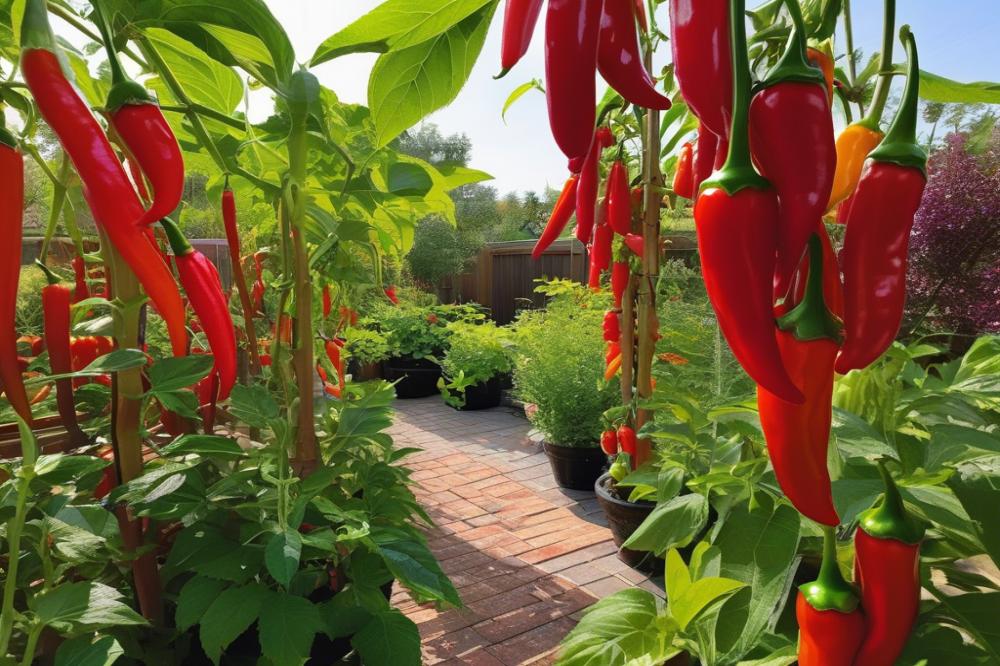Introduction
The Numex Big Jim Chili is a beloved variety among chili pepper enthusiasts. This particular pepper is known for its long, mild heat and robust flavor. Fans enjoy using it in many dishes, from salsas to stuffed peppers. Growing these chili peppers can prove both rewarding and fun for gardeners of all skill levels.
Cultivating chili peppers holds great importance in home gardening. Not only do they offer culinary delights, but they also bring vibrant color to any garden. Understanding proper gardening tips can transform a simple patch of earth into a thriving pepper paradise. Various elements contribute to successful growth, including soil preparation, watering, sun exposure, and fertilization. Each component plays a vital role in the health of the plants.
This article aims to provide readers with the best techniques for growing Numex Big Jim Chili. We will explore essential aspects such as plant care, pest control, and harvesting methods. Learning about growing zones is also crucial for ensuring a successful crop. The variety of chili types available can make a gardener’s journey exciting and flavorful.
Soil Preparation


Ideal Soil Conditions for Numex Big Jim Chili
For successful chili pepper cultivation, soil preparation is key. Adequate nutrients contribute to healthy plant growth. The ideal soil type is loamy or sandy, with good organic matter. This mix promotes drainage while retaining necessary moisture.
Testing Soil pH and Amendments Needed
Testing the pH level of your soil is crucial. Ideally, chili plants thrive in soil with a pH between 6.0 and 6.8. A simple pH testing kit can provide quick results. If the pH is too low, adding lime can help raise it. Conversely, sulfur can decrease a high pH level. Regular testing can guide your amendments.
Recommended Soil Types and Drainage
Well-draining soil is essential for these chili varieties. Heavy clay soil holds too much water, which can harm roots. Choose a site that naturally drains well. Raised beds can also assist in achieving proper drainage. Mixing in compost creates an enriching environment for robust growth. Remember, good drainage and nutrient-rich soil lead to tastier peppers.
Sun Exposure


Optimal sunlight requirements
Chili peppers thrive in sunlight. This warmth is essential for their growth. Aim for at least six to eight hours of direct sunlight each day. The more light they receive, the hotter and tastier they become. Seedlings, in particular, flourish when they soak in the sun’s rays. Too little light can stifle their development and flavor.
Effects of light on chili pepper growth
Light plays a crucial role in photosynthesis. This process helps plants convert sunlight into energy. When chili plants get adequate light, their leaves become vibrant and healthy. Strong stems also develop, supporting the growth of fruit. Insufficient exposure may lead to spindly plants and poor yields. Understanding this balance is key to successful gardening.
Best positions for planting in the garden
Selecting the right position in your garden is vital. A sunny spot near a south-facing wall often works best. Raised beds can also provide the right amount of warmth and drainage. Avoid shady areas, as they can hinder growth. When planting, consider the surrounding plants. Taller plants may cast shadows over smaller chili varieties. Plan the layout wisely for maximum sunlight. Monitor the garden through the seasons to identify sunniest spots. This awareness can help in future planting decisions.
Watering Techniques


Watering Schedule for Numex Big Jim Chili
Careful watering is important for healthy chili peppers. Deep watering helps roots develop well. Start by checking soil moisture. It’s best to water when the top inch of soil feels dry. Typically, you may need to water every two to three days. During hot weather, more frequent watering could be necessary. A consistent schedule creates strong plants. Avoid letting the soil dry out completely, as this can stress the plant.
Signs of Overwatering and Underwatering
Recognizing the signs of overwatering is vital. If leaves turn yellow and become mushy, that could indicate too much water. Root rot can also occur, leading to plant death. On the other hand, underwatering shows different symptoms. Wilting leaves and dry, cracked soil suggest your plants need hydration. Brown, crispy leaf edges are another clear sign. Understanding these signals can help maintain the right moisture balance.
Techniques for Efficient Watering
Efficient watering can save time and resources. One effective method is using drip irrigation. This system delivers water directly to the soil, reducing waste. Mulching around the base of the plants is another helpful strategy. Mulch helps retain moisture in the soil, especially during hot days. Consider using soaker hoses as well. These hoses allow water to seep slowly into the ground. Adjusting your technique based on your growing zone can lead to better results. Remember not to water during the hottest part of the day. Plan for early morning or late afternoon to prevent evaporation. Practicing these gardening tips will lead to a fruitful harvest.
Fertilization Strategies


Nutritional needs play a vital role in the healthy growth of chili peppers. The right balance of nutrients helps the plants achieve their best potential. Chili plants require nitrogen for leafy growth, phosphorus for root development, and potassium for fruit production. An optimal combination of these elements encourages robust, vibrant plants. It’s important to test soil before adding any fertilizers. This way, you can address specific deficiencies. Good soil preparation sets the stage for successful growth.
Types of fertilizers suitable for chili peppers
Various types of fertilizers can support chili plants. Organic options, such as compost or manure, enrich the soil steadily over time. Synthetic fertilizers, like balanced NPK options, provide immediate nutrition. Liquid fertilizers can also work well, as they allow quick absorption. It’s beneficial to consider slow-release pellets for prolonged feeding. Different chili varieties may respond better to specific fertilizer types, so it’s worth experimenting.
Application timing and methods
Knowing when to apply fertilizer is crucial. Start with a nutrient-rich mix when transplanting seedlings into their outdoor beds. During the growing season, a top-dressing can provide extra nutrition. Apply a balanced fertilizer every four to six weeks as the plants mature. Ensure not to overload the plants, as that can lead to burning. Watering helps mix the nutrients into the soil, promoting better uptake. Observing plant growth and color can guide adjustments. Pay attention to any signs of nutrient deficiencies or excesses.
Pest Control Methods
Common Pests Affecting Numex Big Jim Chili
Many gardeners face challenges from pests while cultivating chili peppers. Aphids, spider mites, and whiteflies are a few notorious invaders. These pests suck out the plant’s sap, leading to stunted growth and wilted leaves. Additionally, the risk of disease increases with heavy infestations. Caterpillars and beetles may also attack the fruits and foliage, causing further damage. Understanding these threats is crucial for successful gardening.
Preventive Measures to Take
Prevention starts with healthy soil preparation. Using organic compost helps boost immunity in plants. Select a spot with ample sun exposure for the chili plants to thrive. Regular watering schedules can also keep the plants strong. Introduce companion planting to repel pests naturally. For instance, growing marigolds can deter harmful insects. Keep an eye on the plants regularly. Early detection of pests is vital. Remove any weeds that could harbor pests.
Organic and Chemical Pest Control Options
If pests invade, consider organic solutions first. Neem oil is effective against many insects and is safe for plants. Spraying a mixture of water and dish soap can help eliminate aphids. Diatomaceous earth provides a non-toxic barrier against crawling pests. Chemical options are available when organic methods fail. Insecticides can offer quick relief, but they may harm beneficial insects. Always read labels to understand safe application methods. Use these chemicals responsibly, as they could damage the environment. Balancing pest control with plant health is essential for successful gardening.
Growing Zones and Climate
Ideal Growing Zones for Numex Big Jim Chili
The Numex Big Jim Chili thrives best in USDA hardiness zones 5 to 10. These regions provide the warmth that these chili peppers need to grow and flourish. In warmer climates, the plants can produce larger yields. Conversely, cooler areas may limit growth but still allow for cultivation with proper care.
Effect of Climate on Growth and Yield
Climate plays a significant role in the development of these chili varieties. Warm temperatures, ideally between 70°F to 85°F, enhance fruit setting and ripening. Nights should not drop too low; chilly night temperatures can hinder the plant’s performance. Rainfall also impacts growth. Too much rain can lead to root rot, while too little can stress the plant.
Tips for Growing in Less Than Ideal Conditions
For gardeners facing less than ideal conditions, a few strategies can help. Begin with proper soil preparation. Well-drained and nutrient-rich soil supports growth. Add organic matter to boost fertility. If nights are cooler, consider using row covers to trap heat. When it comes to watering, consistency is important. Drip irrigation helps maintain moisture without waterlogging the roots.
Moreover, ensure adequate sun exposure by selecting a suitable planting area. Generally, these plants need at least six hours of sunlight daily. Consider using fertilizers that are high in potassium and phosphorus to improve fruit quality.
Monitor for pests regularly to protect the plants. Early detection can save your crop. Lastly, harvesting at the correct time maximizes flavor and yield. Enjoy the journey of growing these exceptional chili peppers!
Chili Varieties Comparison
Comparison with other chili varieties
Chili peppers come in various types, each offering distinct flavors and heat levels. The Numex Big Jim chili stands out among them. Medium to large in size, it provides a unique experience compared to smaller, hotter varieties like jalapeños or serranos. Many growers choose milder options for their versatility in cooking. However, this particular chili offers more than just heat. It has a manageable spice level that can appeal to many palates.
When comparing it to popular options such as Anaheim or Poblano, Big Jim excels in both size and flavor. Unlike the Poblano, known for its thick walls, the Big Jim has a thinner skin and tends to grow longer. Those looking for something that can easily be roasted or grilled will find Big Jim ideal. Varieties like Cayenne may be hotter, but this one offers a satisfying taste for simmering salsas or stuffing.
Advantages of growing Numex Big Jim Chili
Growing Big Jim chili peppers has several benefits for both novice and experienced gardeners. Strong plants can withstand varying climates, making them suitable for diverse growing zones. With proper soil preparation and watering techniques, good yields are achievable. Regular fertilization supports healthy growth, contributing to vibrant fruits.
Another advantage involves pest control. These plants often resist common pests, simplifying the gardening process. Big Jim plants typically produce a larger harvest than many smaller varieties. That means you can enjoy your favorite dishes or share them with friends and family without worry.
Flavor profile and culinary uses
The flavor of Numex Big Jim chili peppers is both robust and versatile. It possesses a mild to medium heat that enhances various dishes without overpowering them. Numerous chefs appreciate its ability to complement steaks, tacos, and even pasta.
Incorporating this chili into recipes opens up a world of possibilities. Roasting brings out a sweetness that can transform simple meals. You might find it perfect for chili con carne or adding depth to sauces. Moreover, it works wonderfully in salsas, providing a fresh taste without overwhelming heat.
Experimenting with these can elevate any plate. From grilling to sautéing, the Big Jim chili demonstrates how flavor and heat can harmonize beautifully. Whether you’re a beginner or a seasoned cook, the range of culinary uses makes it a fantastic choice in the kitchen.
Harvesting Techniques
When to harvest Numex Big Jim Chili
Harvest time is crucial for chili peppers. Typically, these peppers are ready to be picked when they reach a mature size and have turned from green to a vibrant red. The best time for harvesting usually falls between 75 to 80 days after planting. Picking peppers too early may result in a lack of flavor and sweetness. Conversely, waiting too long can lead to over-ripening, making them tough. Observing the plant closely helps gardeners determine the right time.
Proper harvesting methods to avoid damage
Using the right tools is important. A sharp pair of garden scissors or pruners will make the task easier and safer. Avoid pulling the peppers directly off the plant, as this can cause injury. Instead, cut the stem just above the pepper. This technique minimizes any potential damage to the plant and preserves its health for future harvests. Handling the fruits with care is essential. Hitting or bruising them can lower their quality.
Post-harvest handling for best quality
Proper post-harvest care helps maintain the freshness of the peppers. After harvesting, gently place them in a basket or box lined with soft cloth. Avoid stacking them too high, as crushing can lead to spoilage. Store the peppers in a cool, dry place away from direct sunlight. For longer storage, consider refrigeration. The optimum conditions help to retain flavor and texture. Inspect any peppers for signs of pests or damage before storing. Following these gardening tips can greatly improve your yield of chili varieties in the long run.
Wrapping Up the Adventure of Growing Chili Peppers
To recap the best techniques for growing a popular variety of chili, consider the basics. Start with healthy seeds and choose a sunny, well-drained location for planting. Water the plants regularly but avoid overwatering, as this can lead to root problems. Fertilizing your plants with a balanced fertilizer will promote strong growth and lush fruit production. Monitoring for pests is crucial. Early detection can save your crop from damage.
Trying your hand at growing these peppers can be rewarding. With their mild to medium heat, the flavor of fresh chili can elevate countless dishes. Each pepper offers a satisfying crunch and a touch of warmth. Many gardeners discover that nurturing these plants fosters a deeper appreciation for fresh ingredients. Enjoying the fruits of your labor brings a sense of accomplishment.
Final thoughts revolve around the joy of home gardening. The satisfaction of harvesting your own chili peppers is hard to match. Cooking with fresh produce you’ve grown can transform your meals into something special. Whether used in salsas, stuffed into dishes, or simply enjoyed on their own, homegrown peppers provide a unique taste experience. Embrace the journey and explore the many gardening tips available to enhance your gardening success.



